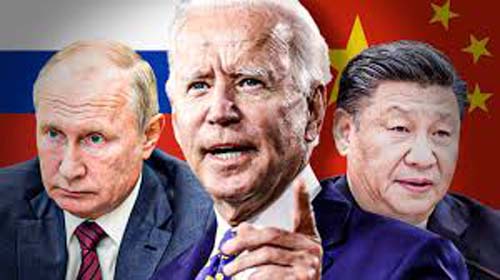
Biden needs clear strategy to end US’ tit-for-tat approach
Nadim Shehadi
A multipolar world is one of competing visions, strategies and actions. During inauguration week in the US, there is much speculation about the new administration’s worldview and the position of the Middle East in that context.
How seriously one can take US election campaign promises? In the heat of the moment, candidates trash their opponent’s policies and promise to dismantle or reverse them. But is there a vision behind all this? The US’ allies in the region have existential stakes in the matter and are on the edge of their seats in anticipation.
Since 9/11, the Arab region has been at the center of these debates. The war on terror, Iraq, Syria, Iran, Turkey, the Arab Spring, and Libya have all raised questions about the role of the US and its limits.
Former Secretary of State Condoleezza Rice summed up the Bush era’s vision in her Cairo speech of 2005: “For 60 years, my country, the United States, pursued stability at the expense of democracy in this region here in the Middle East — and we achieved neither. Now, we are taking a different course. We are supporting the democratic aspirations of all people.”
The “neocons” blamed the 9/11 attacks on the “dual containment” policies of the 1980s and 1990s, which brought us the Iran-Iraq War and sanctions, with dictators like Saddam Hussein consolidating their power as a result and becoming more tyrannical. Saddam even invaded Kuwait and massacred his own people. The consequences were catastrophic and regime change was the answer. This was the rationale behind the Iraq invasion of 2003, which took inspiration, as George W. Bush himself said, from the Second World War’s transformation of the Axis Powers into democracies. “Every nation has learned, or should have learned, an important lesson: Freedom is worth fighting for, dying for, and standing for — and the advance of freedom leads to peace,” he said soon after Saddam’s regime fell.
However, the Iraq invasion resulted in a tragedy. Apart from whatever mistakes were made in its aftermath, it was correctly seen as a threat by other regimes in the region, which feared they would be next. Syria and Iran contributed to its failure through the creation of chaos aimed at driving the Americans out of the region. They succeeded, as the US ultimately chose withdrawal and capitulation.
President Barack Obama reversed Bush’s approach. Instead of confrontation, he chose engagement; and instead of regime change, he made deals with both Iran and Syria. Nancy Pelosi and John Kerry both visited Bashar Assad in Damascus while he was sending extremists across the border to defeat the US in Iraq. Obama, in his 2009 Cairo speech, reassured all the dictators of the region that the US would not pursue regime change and that he understood that they have special circumstances. “So let me be clear: No system of government can or should be imposed upon one nation by any other,” he said. “Each nation gives life to this principle in its own way, grounded in the traditions of its own people. America does not presume to know what is best for everyone.”
The result was the US abandoning Iraq, negotiations with Iran over the nuclear deal, and half-hearted support to the revolts in Syria, leading to Obama’s retraction from his “red lines” — all with catastrophic consequences. Obama also had tense relations with Israel and with traditional Arab allies, who perceived the nuclear deal as giving Iran’s Islamic Revolutionary Guards Corps (IRGC) a free hand to create havoc in Palestine, Lebanon, Syria, Iraq and Yemen.
Donald Trump was more of a disruptor, but he also followed that pattern of reversing most of his predecessor’s policies, including in the Middle East. He challenged the Iran deal and asked for it to be renegotiated, confronted Tehran in Syria and Iraq, and declared the IRGC a terrorist organization and targeted its leadership, culminating in the January 2020 assassination of Qassem Soleimani. He also pursued a policy of extreme pressure by imposing crippling economic sanctions on Iran, the Syrian regime, and the IRGC and its allies. While Obama and Kerry tried to resolve the Israeli-Palestinian conflict, Trump addressed it as an Arab-Israeli problem. US-led rapprochement between some Gulf states and Israel led to successful “normalization deals” with four Arab countries.
All the indications are that Biden will continue the pendulum swing pattern and reverse Trump’s policies.
All the indications are that Joe Biden will continue the pendulum swing pattern and reverse Trump’s policies. During his election campaign, he promised to restore the Iran deal and was critical of Trump’s engagement with the Gulf states. He will refocus on the Palestinian-Israeli dimension of that conflict but his policy toward the Assad regime in Syria is, at best, ambiguous.
Is that all there is to it? There is a common thread in the lack of appetite for war and the need to pivot out of the region. A pattern of consecutive administrations undoing the work of their predecessor without a clear goal is worrying.
This is a legitimate concern. Domestic politics are certainly important, but the pattern of tit for tat without any rationale or strategy is indeed worrying. This is not the case for other powers competing in the region: China has a worldview based on its Belt and Road Initiative, Russia and Turkey aim to restore past influence, and Iran has a clear strategy of perpetual war against the US and, through its IRGC proxies, collapsing states, building alternative institutions and gaining control. Whether they will succeed or not is beside the point; in the US, partisan politics will never amount to a national strategy.
Nadim Shehadi is the executive director of the LAU Headquarters and Academic Center in New York and an Associate Fellow of Chatham House in London.
